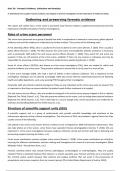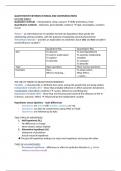Essay
BTEC Applied Science Unit 23A - Gathering and preserving forensic evidence (Distinction)
- Course
- Institution
- Book
Exemplar assignment for Unit 23A, the first assignment in BTEC Applied Science Unit 23, which is about how crime scenes are processed and how to preserve forensic evidence. This assignment was awarded a DISTINCTION. Please don't hesitate to message me if you have any questions about this assignment
[Show more]





